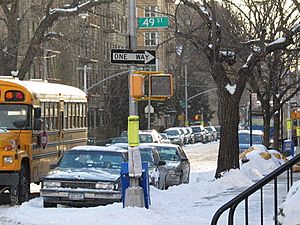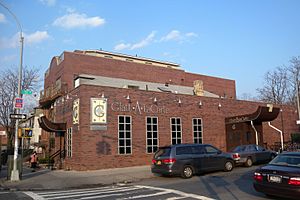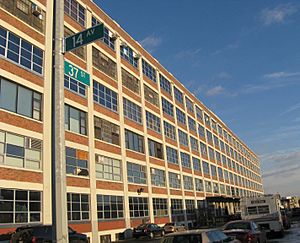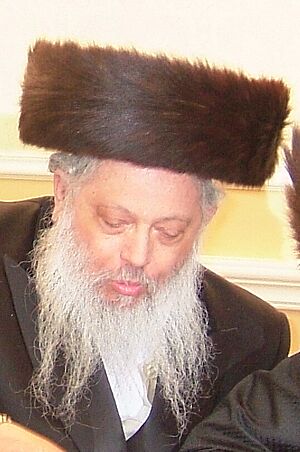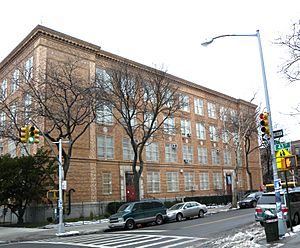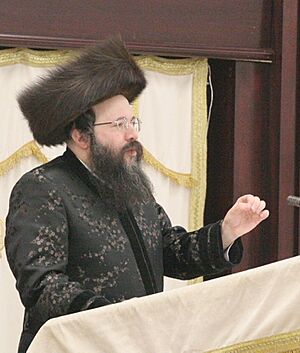Borough Park, Brooklyn facts for kids
Quick facts for kids
Borough Park
|
|
|---|---|
|
Neighborhood of Brooklyn
|
|
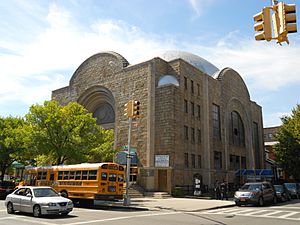
|
|
| Country | |
| State | |
| City | |
| Borough | |
| Community District | Brooklyn 12 |
| Languages | |
| Area | |
| • Total | 2.071 sq mi (5.36 km2) |
| Population
(2010)
|
|
| • Total | 153,470 |
| • Density | 74,104/sq mi (28,612/km2) |
| Ethnicity | |
| • White | 77.0% |
| • Asian | 11.7% |
| • Hispanic (of any race) | 9.4% |
| • Black | 0.7% |
| • Other | 1.2% |
| Economics | |
| • Median household income | $37,438 |
| Time zone | UTC−5 (Eastern) |
| • Summer (DST) | UTC−4 (EDT) |
| ZIP Codes |
11204, 11218–11220
|
| Area code | 718, 347, 929, and 917 |
Borough Park (also called Boro Park) is a busy neighborhood in the southwestern part of Brooklyn, a large area of New York City. It shares borders with other neighborhoods like Bensonhurst and Sunset Park.
Borough Park is known for its diverse economy. It is home to one of the largest Orthodox Jewish communities outside of Israel. Many Orthodox and Haredi families live here. These families often have many children, which means the population in Boro Park is growing quickly.
The neighborhood is part of Brooklyn Community District 12. Its main ZIP Code is 11219. The New York City Police Department's 66th Precinct patrols the area.
Contents
Borough Park's History
How Borough Park Started
The area was first known as Blythebourne. It was a small village with cottages built in 1887. A developer named William Reynolds later added more homes.
Early transportation included the Brooklyn, Bath, and Coney Island Railroad. This was a steam train line built in the 1860s. Today, it's the elevated BMT West End Line (D train). Another steam train, the Sea Beach Railroad, was built in 1879. It was later updated and now serves the N train subway line.
In 1902, State Senator William H. Reynolds bought land northeast of Blythebourne. He named this new area Borough Park. By the 1920s, Blythebourne became part of Borough Park.
Jewish Community Grows
Jewish immigrants started moving to Borough Park around 1904–1905. By 1914, a YMHA (Young Men's Hebrew Association) was formed. They bought land to build a large community center. In the 1930s, 13th Avenue was full of street vendors. Later, the city opened a public market to organize the street trade.
Many Yemenite Jews moved to Borough Park in the late 1920s and early 1930s. They created their own community and built a synagogue called Ohel Shalom. It moved from a small shop to a larger building on 12th Avenue.
In the 1980s, the neighborhood changed a lot. More Hasidic Jewish families moved in. By 1983, about 85% of people in Borough Park were Jewish. New shops and restaurants opened on 13th Avenue to serve the growing Orthodox Jewish community. Stores selling imported goods and technology also opened. By the late 1990s, businesses began selling Jewish books, music, and videos online. The area became a very large Jewish community.
"Baby Boom Capital" of New York City
In 2000, about 76,600 Jewish people lived in Borough Park. Since then, the population has grown even more. The New York Post newspaper called it the "baby boom capital" of New York City. This is because of the very high birth rate. In 2004, Borough Park had 4,523 births, the most in the city. The population reached 140,000 by 2011.
Many babies are born at Maimonides Medical Center in Borough Park. Its children's hospital is one of only three in New York City. Maimonides handles more births than any other hospital in New York State.
Large Hasidic families often need bigger homes. This has led to many construction projects in the neighborhood. Homes are being built or renovated with larger bedrooms and kitchens. A 1998 article said that Borough Park had the most private construction permits in Brooklyn. A 1992 law helped this growth. It allowed residents to build on 65% of their land, making yards smaller.
Business Growth in Borough Park
Thirteenth Avenue is a main shopping street. It is about one mile long, from 39th to 55th Streets. Many stores there sell items for Jewish households. Hasidic Jews from all over come to these stores to buy kosher items. Businesses have grown thanks to the increasing Jewish population and online sales.
The community also welcomes many visitors, especially from Israel. The Park House Hotel opened in 1987. It was the first kosher hotel in Borough Park. In 1999, The Avenue Plaza Hotel opened. These hotels and local shops cater to visiting Hasidic tourists.
Borough Park's Population
Based on the 2010 United States census, Borough Park had 106,357 people. This was an increase of 5,302 people since 2000. The neighborhood covers about 1,239 acres.
Most residents are White (77.0%). About 11.7% are Asian, and 9.4% are Hispanic. Less than 1% are Black.
In 2018, the average life expectancy in Borough Park was 84.2 years. This is higher than the average for New York City. Many residents are children and young adults. About 34% are under 18, and 28% are between 25 and 44.
In 2016, the average household income was $45,364. About 28% of residents lived in poverty in 2018. This is higher than the average for Brooklyn and New York City. However, only 6% of residents were unemployed. This is lower than the city average. Many residents (64%) have trouble paying their rent.
Climate in Borough Park
Borough Park has a humid subtropical climate. This means it has hot, humid summers and mild winters. It also gets rain throughout the year.
| Climatic scheme | Initials | Description |
|---|---|---|
| Köppen system | Cfa | humid subtropical climate |
| Trewartha system | Do | Temperate oceanic climate |
| Alisov system | N/A | Temperate climate |
| Strahler system | N/A | Moist continental climate |
| Thornthwaite system |
|
Moist subhumid |
| Neef system | N/A | Temperate climate |
| Weather chart for Borough Park | |||||||||||||||||||||||||||||||||||||||||||||||
|---|---|---|---|---|---|---|---|---|---|---|---|---|---|---|---|---|---|---|---|---|---|---|---|---|---|---|---|---|---|---|---|---|---|---|---|---|---|---|---|---|---|---|---|---|---|---|---|
| J | F | M | A | M | J | J | A | S | O | N | D | ||||||||||||||||||||||||||||||||||||
|
3.5
40
28
|
3.6
42
29
|
4
51
36
|
4.5
62
45
|
4.3
72
55
|
4.7
80
64
|
5.1
86
71
|
5.2
84
69
|
3.9
77
63
|
5.7
65
52
|
3.7
54
42
|
4.6
45
34
|
||||||||||||||||||||||||||||||||||||
| temperatures in °F precipitation totals in inches |
|||||||||||||||||||||||||||||||||||||||||||||||
|
Metric conversion
|
|||||||||||||||||||||||||||||||||||||||||||||||
| Month | Jan | Feb | Mar | Apr | May | Jun | Jul | Aug | Sep | Oct | Nov | Dec | Year |
|---|---|---|---|---|---|---|---|---|---|---|---|---|---|
| Record high °F (°C) | 72 (22) |
73 (23) |
82 (28) |
92 (33) |
94 (34) |
97 (36) |
104 (40) |
101 (38) |
97 (36) |
92 (33) |
80 (27) |
72 (22) |
104 (40) |
| Mean maximum °F (°C) | 60.6 (15.9) |
59.7 (15.4) |
71.4 (21.9) |
83.5 (28.6) |
88.5 (31.4) |
92.1 (33.4) |
96.6 (35.9) |
94.3 (34.6) |
90.5 (32.5) |
79.7 (26.5) |
70.9 (21.6) |
62.8 (17.1) |
97.8 (36.6) |
| Mean daily maximum °F (°C) | 40.1 (4.5) |
41.9 (5.5) |
50.5 (10.3) |
62.1 (16.7) |
72.0 (22.2) |
80.1 (26.7) |
85.8 (29.9) |
84.2 (29.0) |
77.2 (25.1) |
64.9 (18.3) |
54.3 (12.4) |
44.8 (7.1) |
63.2 (17.3) |
| Daily mean °F (°C) | 33.9 (1.1) |
35.3 (1.8) |
43.2 (6.2) |
53.7 (12.1) |
63.5 (17.5) |
72.1 (22.3) |
78.2 (25.7) |
76.6 (24.8) |
69.9 (21.1) |
58.3 (14.6) |
48.0 (8.9) |
39.3 (4.1) |
56.0 (13.4) |
| Mean daily minimum °F (°C) | 27.7 (−2.4) |
28.8 (−1.8) |
35.8 (2.1) |
45.3 (7.4) |
55.0 (12.8) |
64.2 (17.9) |
70.5 (21.4) |
69.1 (20.6) |
62.6 (17.0) |
51.6 (10.9) |
41.5 (5.3) |
33.8 (1.0) |
48.8 (9.4) |
| Mean minimum °F (°C) | 10.0 (−12.2) |
12.7 (−10.7) |
20.1 (−6.6) |
34.2 (1.2) |
44.1 (6.7) |
53.4 (11.9) |
62.6 (17.0) |
61.2 (16.2) |
51.4 (10.8) |
38.7 (3.7) |
28.4 (−2.0) |
19.2 (−7.1) |
7.8 (−13.4) |
| Record low °F (°C) | 3 (−16) |
−1 (−18) |
11 (−12) |
26 (−3) |
33 (1) |
50 (10) |
57 (14) |
56 (13) |
47 (8) |
32 (0) |
17 (−8) |
7 (−14) |
−1 (−18) |
| Average precipitation inches (mm) | 3.53 (90) |
3.60 (91) |
3.95 (100) |
4.54 (115) |
4.25 (108) |
4.74 (120) |
5.06 (129) |
5.16 (131) |
3.87 (98) |
5.67 (144) |
3.72 (94) |
4.63 (118) |
52.72 (1,338) |
| Average rainfall inches (mm) | 2.55 (65) |
2.44 (62) |
3.50 (89) |
4.51 (115) |
4.25 (108) |
4.74 (120) |
5.06 (129) |
5.16 (131) |
3.87 (98) |
5.65 (144) |
3.66 (93) |
4.16 (106) |
49.55 (1,260) |
| Average snowfall inches (cm) | 9.8 (25) |
11.6 (29) |
4.5 (11) |
0.3 (0.76) |
0.0 (0.0) |
0.0 (0.0) |
0.0 (0.0) |
0.0 (0.0) |
0.0 (0.0) |
0.2 (0.51) |
0.6 (1.5) |
4.7 (12) |
31.7 (79.77) |
| Average precipitation days | 10.7 | 10.6 | 10.3 | 11.3 | 12.1 | 11.9 | 10.4 | 9.8 | 7.7 | 10.4 | 9.5 | 11.6 | 126.3 |
| Average rainy days | 7.1 | 7.1 | 8.5 | 11.1 | 12.1 | 11.9 | 10.4 | 9.8 | 7.7 | 10.3 | 9.2 | 9.5 | 114.7 |
| Average snowy days | 3.6 | 3.5 | 1.8 | 0.2 | 0.0 | 0.0 | 0.0 | 0.0 | 0.0 | 0.1 | 0.3 | 2.1 | 11.6 |
Safety and Services
Fire Safety in Borough Park
The New York City Fire Department (FDNY) has two fire stations in Borough Park.
- Engine Company 282/Ladder Company 148 is at 4210 12th Avenue.
- Engine Company 247 is at 1336 60th Street.
Post Offices and ZIP Codes
Borough Park uses several ZIP Codes: 11204, 11218, 11219, and 11230. The main one is 11219. The United States Post Office has a branch called Blythebourne Station at 1200 51st Street.
Religion in Borough Park
Borough Park is home to many Hasidic groups. The largest is the Bobov community. Other groups like Boyan, Belz, Ger, and Satmar also live here. There are also Lithuanian Jews and Sephardic Jews, and a smaller number of Modern Orthodox Jews.
About 37% of Jewish people in Brooklyn consider themselves Orthodox. Borough Park is often called the "heartland" for New York's Orthodox Jewish population. Since the 1970s, the neighborhood has become very Orthodox. Many Hasidic Jews, including Holocaust survivors, moved here. They brought a more traditional Jewish religious way of life. A 2002 study showed that most Jews in Borough Park identify as Orthodox.
Religious Practices and Traditions
The Orthodox Jewish community follows halakha (Jewish law) very closely. They observe Shabbos (the Jewish Sabbath) strictly. On Friday evenings before sundown, a siren might sound to mark the start of Shabbos. Many families do not own televisions or go to movies. Children attend yeshivas (Jewish private schools) instead of public schools. Girls dress modestly, covering their knees and elbows. At events like weddings, men and women sit separately.
Stores in Borough Park sell only kosher food. This food is prepared under the guidance of rabbis. There was some discussion about building an eruv in Borough Park. An eruv is a special boundary that allows carrying items on Shabbos. One was built in 1999–2000, covering about 225 blocks.
Mikvahs (Jewish ritual baths) are found throughout the neighborhood. They are an important part of Orthodox Jewish life. They are usually kept private.
Bobov Community
Borough Park is the main center for the large Bobov Hasidic community. This group includes thousands of families. They also have followers in other countries like Canada, England, and Israel.
Satmar Community
Satmar is another large Hasidic group in Brooklyn. They are known for their strict religious rules and traditional lifestyle. Satmar runs many schools. They have two large boys' schools and a big girls' school in Borough Park. The girls' school, Bais Ruchel, used to be a public school.
Education in Borough Park
Borough Park has fewer college-educated residents compared to the rest of New York City. In 2018, about 32% of adults had a college degree. However, 23% had less than a high school education.
More students in Borough Park are doing well in reading and math. Reading scores went from 50% in 2000 to 53% in 2011. Math scores jumped from 46% to 70% in the same period.
Fewer elementary school students miss school in Borough Park. Only 11% missed 20 or more days in a school year. This is lower than the city average of 20%. Also, 77% of high school students graduate on time, which is higher than the city average.
Schools in the Neighborhood
The New York City Department of Education runs the public schools in District 20. PS/IS 180 Homewood School is a public school for grades K-8. It gets students from other neighborhoods too. Many elementary schools have smaller class sizes because many children attend private Jewish schools called yeshivas. For example, PS 164 had small classes because many children went to yeshivas.
Most parents in Borough Park send their children to yeshivas. Almost all children from Hasidic families attend local yeshivas for boys and Bais Yaakov-type schools for girls. This means public schools like The Montauk Intermediate School have fewer students. The New York City Department of Education wanted to use the empty space for a new small school. However, the Hasidic community was concerned about this. They protested the decision.
Instead, an all-girls school, the Urban Assembly for School for Criminal Justice, moved into the Montauk building. It shares the building with The Montauk School. The Montauk School now has many Asian students, and almost a third are learning English. Together, these schools serve nearly 1600 students.
Public Library
The Brooklyn Public Library (BPL) has a branch in Borough Park. It is located at 1265 43rd Street, near 13th Avenue.
Transportation in Borough Park
Several New York City Bus routes serve Borough Park, including the B8, B9, B11, B16, B35. There is also a private bus route, B110, to Williamsburg.
The New York City Subway has several lines here:
- The BMT West End Line (D train) stops at 55th Street, 50th Street, and Fort Hamilton Parkway.
- The IND Culver Line (F <F> trains) runs along McDonald Avenue.
- The BMT Sea Beach Line (N W services) stops at Fort Hamilton Parkway.
Borough Park's main avenues run north to south. The busiest shopping areas are on 13th, 16th, and 18th Avenues.
Famous People from Borough Park
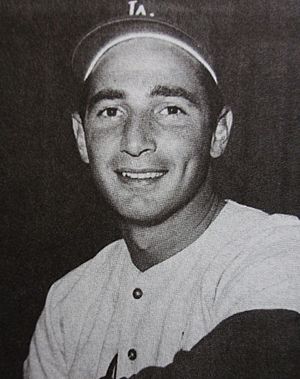
Many notable people have lived in Borough Park, including:
- Helène Aylon (1931–2020), an artist.
- Richard J. Bernstein (born 1932), a philosopher.
- Jay Black (born 1938), a singer.
- Yaakov Bleich (born 1964), Chief Rabbi of Kyiv, Ukraine.
- Menachem Daum (born c. 1947), a documentary filmmaker.
- Alan Dershowitz (born 1938), a law professor and author.
- Simcha Eichenstein, a New York state assemblyman.
- Simcha Felder, a New York state senator.
- Norman Finkelstein (born 1953), a political scientist.
- Joseph Flom (1923–2011), a lawyer.
- David Geffen (born 1943), a business leader and producer.
- Eli Gerstner (born 1980), a singer and songwriter.
- Buddy Hackett, a comedian and actor.
- Ben Zion Aryeh Leibish Halberstam, the current leader of Bobov Hasidim.
- Sandy Koufax (born 1935), a famous baseball pitcher.
- Lou Reed, a singer, songwriter, and musician.
- John Saxon (1936–2020), a film actor.
- Arnold Schuster, known for helping capture a bank robber.
- Zalman Teitelbaum, a leader of Satmar Hasidim.
- Mordechai Dovid Unger, a leader of Bobov 45 Hasidim.
See also
In Spanish: Borough Park (Brooklyn) para niños


